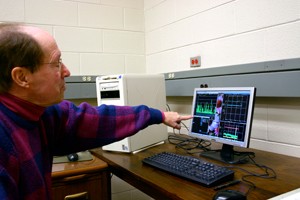
Physics Bridges Long Distances to Study Tiny Particles
Neutrinos are everywhere.
These extremely tiny particles many times smaller than the electrons that orbit individual atoms are thought to play a role in everything from solar energy to radioactive decay to the dark matter that makes up most of the universe.
Neutrinos small size and the difficulty in isolating them for study has made it hard for physicists to fully understand how they relate to the other subatomic particles that form the building blocks of atoms and molecules. But an experiment being conducted by researchers from the University of Cincinnati and 17 other universities could unlock critical secrets about the nature of neutrinos.
This is really basic research, but its important in that respect, said
Randy Johnson, professor of
, as he described the Booster Neutrino Experiment, known as the MiniBooNE experiment, currently underway at the
Fermi National Accelerator Laboratory
near Chicago.
In the mid 1990s, an experiment at Los Alamos National Laboratory suggested that neutrinos behave in ways that violate scientists theories about particle physics. Three types, or flavors, of neutrinos had been identified at that point, each associated with a specific type of subatomic particle. The Los Alamos experiment suggested that there might be a fourth flavor of neutrino, one that was immune to all known forces except gravity.
A fourth flavor of neutrinos cant come about in our normal physics, said Johnson.

BooNE collaborators included Randy Johnson and J. L. Raaf from UC. (Photo courtesy of Fermilab)
The MiniBooNE experiment was launched in 1997 to verify or disprove the Los Alamos findings, and UC researchers have been part of the program since its start. Johnson and his research team sourced the 250,000 gallons of ultra-pure mineral oil used to fill the experiments giant neutrino detector, and they continue to monitor the experiment's data stream.
I, as an experimenter, have an interest in making sure my experiment runs correctly, he said.
Johnson and his colleagues set up a remote workstation in October, which allows them to share the 24-hour duty of monitoring the experiments high-energy equipment. From two computers, McMicken physicists can monitor the experiments high-energy proton beam, 173,000-amp particle collector and the 36-foot diameter neutrino detectors 1,550 sensors. Without the remote station, researchers would have to go to Chicago to participate in the experiment.
What weve done here is opened the experiment up for more scientists to participate, he said. We have a lot of professors and graduate students who would like to take monitoring shifts.
And along with providing a new research opportunity on campus, Johnson said the remote monitoring station has caught potentially experiment-damaging problems before they can derail the experiment. During the second week of remote monitoring, Johnson identified an error that had locked up a data-logging computer, and also spotted an error in the computer that guides the experiments high-energy photon beam.
We were able to fix that in about 20 minutes, he said of the second error, which could have let loose a stray beam of energy powerful enough to melt the experiments vital aluminum components.
The MiniBooNE experiment is scheduled to continue collecting data until June 2009, but already it has produced important results. Its data ruled out with 98 percent certainty the existence of the fourth flavor of neutrino that the Los Alamos experiment had suggested. But other results suggest that the three existing flavors of neutrinos may interact in ways not predicted by physicists.
For Johnson, that puzzling result is good news.
Thats something thats fun in any kind of experiment. You find something a little weird, and people come in and give you ideas about what it means, he said. Thats where the theorists come in. Theyre going to have a great time figuring this out.
Related Stories
When does the fall semester start for Ohio college students?
July 28, 2025
The dog days of summer are revving up, but the back-to-school season is upon us. Most colleges and universities in Ohio start in the latter half of August, according to The Columbus Dispatch.
Why jumping spiders mimic wasps
July 25, 2025
In nature's game of survival and attraction, appearances can deceive. University of Cincinnati biologists found that even artificial intelligence mistakes spiders for wasps. The question is why spiders would want to look like their predators.
What is geography?
July 25, 2025
If you like working with data analytics, traveling, or have an interest in why things are where, then there is a place in Geography for you. “If you say ‘Geography,’ most people think of the category on Jeopardy or memorizing their state capitals. Of course, that's very important too,” said Kevin Raleigh, UC’s Department Head of Geography, as well as the Interim Director of European Studies. “Geography looks at why things are important where.” The different uses of geographical knowledge have evolved but never lessened. Now that geographers have identified most, if not all, of the places on earth, they have the freedom to apply this knowledge to real world issues.
